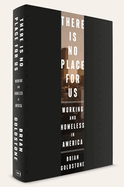
Journalist and anthropologist Brian Goldstone compassionately brings readers to the city of Atlanta, Ga., and the efforts of several "working poor" families who are trying to keep roofs over their heads in There Is No Place for Us. With Goldstone's true-to-life reporting, readers are not guaranteed happy endings to every story.
Goldstone shows readers the precarity of being working class in the 21st-century United States. Even Maurice and Natalia Taylor, who were married and both full-time workers, found that their family wasn't safe from homelessness. Families shuffle from "dingy" apartments to the living room floors of relatives, to extended-stay motels, the backseats of cars, and even unsafe rooming houses. The Simmons family found themselves secretly staying in a storage room in the "January chill" and sleeping "on a thin cushion of bath towels." Without reliable housing, adults find employment increasingly challenging to maintain. Through the accounts of the families featured, Goldstone illustrates how difficult it is to get ahead as debts and evictions pile up. Aid is hard, if not impossible, to obtain.
As he followed along with these families between 2019 and 2022, Goldstone witnessed the fallout of the Covid-19 pandemic on their lives. Throughout this carefully observed work of reportage, Goldstone viscerally portrays the stress and agony the families experience. Goldstone takes pains to be truthful yet depicts challenges without judging or condemning the choices any of these families made when there were simply no good choices available.
Realistic, gritty, and infuriating, There Is No Place for Us is an excellent companion to Evicted or Poverty, Inc. --Alyssa Parssinen, freelance reviewer and former bookseller

